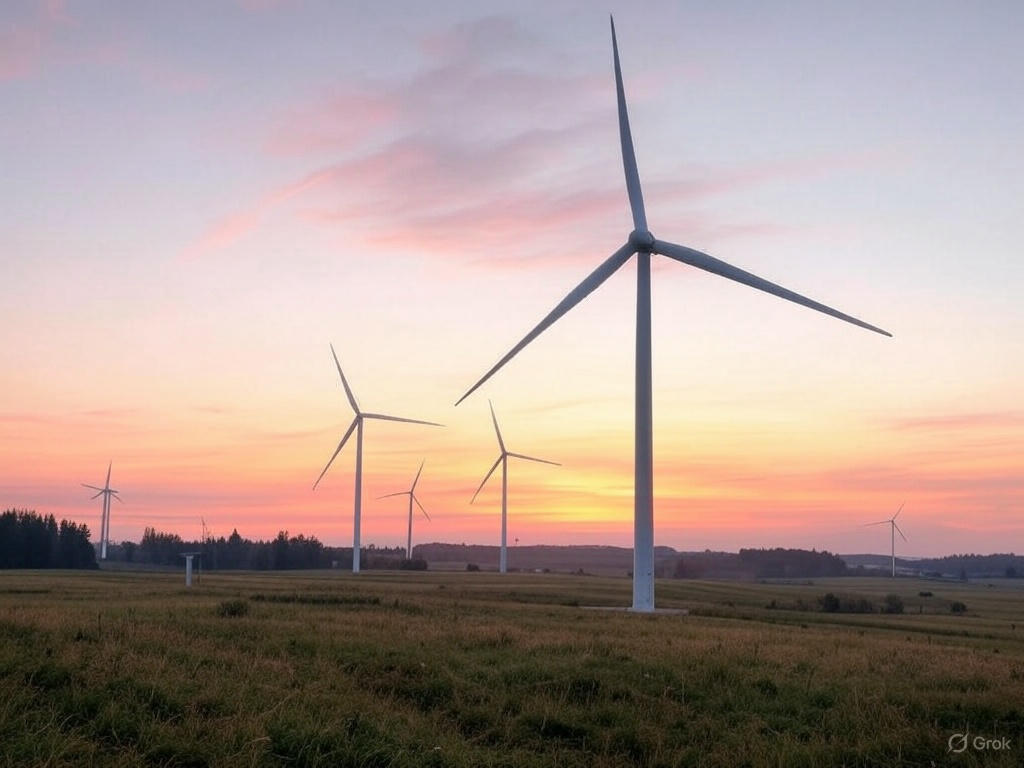Powering the Future: Understanding Renewable Energy
Introduction: Our Changing Energy Landscape
For most of modern history, humanity has powered its remarkable technological progress primarily through fossil fuels—coal, oil, and natural gas. These energy-dense, convenient fuels enabled the Industrial Revolution and the unprecedented economic growth and quality of life improvements that followed. However, this progress has come with significant costs: climate change, air and water pollution, resource depletion, and geopolitical tensions.
Today, we stand at a critical inflection point in our energy history. Renewable energy technologies have matured from experimental alternatives to mainstream, cost-competitive options that are being deployed at unprecedented rates across the globe. This transition represents not just a technological shift but a fundamental reimagining of how we generate, distribute, and use energy.
To understand renewable energy and its potential, we need to first understand what makes energy “renewable” and how these sources differ from conventional energy systems that have dominated for generations.
The Fundamentals: What Makes Energy “Renewable”?
At its core, renewable energy comes from sources that are naturally replenished on a human timescale. This stands in stark contrast to fossil fuels, which took millions of years to form and are being depleted much faster than they can be replenished.
Almost all renewable energy ultimately derives from one of three primary sources:
- Solar energy from the sun (which directly powers solar technologies and indirectly drives wind, hydropower, and biomass)
- Gravitational energy (primarily from the moon’s gravitational pull creating tides)
- Geothermal energy from the Earth’s internal heat
These natural flows of energy constantly surround us and are virtually inexhaustible from a human perspective. The total solar energy reaching Earth’s surface is approximately 10,000 times greater than all human energy consumption. The challenge has been developing technologies efficient enough to capture, convert, and utilize these diffuse energy flows cost-effectively.
Let’s examine each major type of renewable energy to understand how they work, their current state of development, and their unique advantages and challenges.
Solar Energy: Harnessing the Power of Sunlight
How Solar Energy Works
Solar energy technologies directly convert sunlight into electricity or heat. The most common approaches include:
Photovoltaic (PV) Solar Cells: These devices convert sunlight directly into electricity using the photovoltaic effect, discovered by Alexandre-Edmond Becquerel in 1839. When photons (light particles) strike a semiconductor material like silicon, they transfer their energy to electrons, creating an electric current.
Modern solar panels typically convert 15-22% of the sunlight that hits them into electricity, though laboratory cells have achieved efficiencies over 47%. A typical residential solar system might include:
- 15-25 silicon solar panels mounted on a roof or ground-mounted rack
- An inverter to convert the DC electricity from the panels to AC electricity used by homes
- Monitoring systems to track performance
- Potentially a battery storage system to store excess production
Concentrated Solar Power (CSP): Unlike PV systems that directly generate electricity, CSP systems use mirrors or lenses to focus sunlight onto a small area, creating intense heat. This heat drives a conventional steam turbine to generate electricity. Major CSP technologies include:
- Parabolic troughs (curved mirrors focusing light onto tubes containing heat-transfer fluid)
- Solar power towers (fields of mirrors directing sunlight to a central receiver atop a tower)
- Dish/engine systems (parabolic dish-shaped mirrors focusing light onto a receiver)
Solar Thermal: These systems capture the sun’s heat for direct use in water heating, space heating, or industrial processes. A simple solar water heater might use dark-colored panels to absorb solar energy and heat water circulating through tubes.
Current Status and Market Trends
Solar energy has experienced exponential growth and dramatic cost reductions:
- Rapidly Declining Costs: The cost of solar PV modules has fallen by approximately 99% since 1976, with a 90% decline just since 2009
- Growing Capacity: Global solar capacity reached over 1,000 gigawatts (GW) in 2022, up from just 40 GW in 2010
- Increasing Competitiveness: Solar PV now offers the lowest cost of electricity in history in many regions, with utility-scale projects regularly achieving prices below $30/MWh (3 cents per kilowatt-hour)
This remarkable cost decline has transformed solar from a niche, subsidized technology to the cheapest form of new electricity generation in many regions. Countries leading in solar deployment include China (about 33% of global capacity), the United States, Japan, and Germany, though growth is occurring worldwide.
Advantages and Challenges
Advantages of Solar Energy:
- Abundant Resource: The sun delivers more energy to Earth in one hour than humanity uses in an entire year
- Zero Emissions Operation: No greenhouse gases or air pollutants during electricity generation
- Modularity: Systems can scale from tiny calculators to massive utility installations
- Low Operating Costs: Minimal maintenance and zero fuel costs
- Distributed Generation: Can be installed at point of use, reducing transmission losses and infrastructure needs
Challenges:
- Intermittency: Production varies with weather conditions and time of day
- Land Use: Utility-scale installations require significant land area (though this can be mitigated with dual-use approaches like agrivoltaics)
- Initial Costs: Despite falling prices, upfront investment can still be substantial
- Material Intensity: Manufacturing requires specific minerals and metals, creating supply chain considerations
- Energy Storage: Maximizing solar’s potential requires parallel development of storage technologies
Notable Developments and Examples
Floating Solar: Installations on water bodies reduce land use competition and can achieve higher efficiency due to cooling effects. China’s 320 MW Dezhou Dingzhuang Floating Solar Farm is among the world’s largest.
Building-Integrated Photovoltaics (BIPV): Solar cells integrated into building materials like windows, facades, and roofing materials. Examples include Tesla’s Solar Roof and transparent solar windows developed by several companies.
Agrivoltaics: The practice of co-locating solar panels with agricultural production, allowing land to serve dual purposes. Studies show some crops actually benefit from the partial shading provided by elevated panels.
Desert Solar Megaprojects: Massive installations in sunny desert regions, such as the Benban Solar Park in Egypt (1.8 GW) and planned developments in Saudi Arabia’s NEOM project.
Wind Energy: Capturing the Power of Moving Air
How Wind Energy Works
Wind energy harnesses the kinetic energy of moving air to generate electricity. Modern wind turbines operate on a simple principle: wind causes large blades to rotate, which turns a shaft connected to a generator that produces electricity.
The fundamental components of a modern wind turbine include:
- Rotor and Blades: Usually three aerodynamically designed blades (typically 30-80 meters long) that capture wind energy
- Nacelle: The housing that contains the generator, gearbox, and control systems
- Tower: Typically 80-120 meters tall, supporting the nacelle and rotor, and providing access for maintenance
- Foundation: Underground structure supporting the entire turbine
- Control Systems: Electronics that monitor conditions and adjust blade pitch and turbine orientation
Wind turbines typically begin generating electricity at wind speeds of about 3-4 meters per second (m/s), reach their rated capacity at around 12-15 m/s, and shut down for safety at about 25 m/s. Modern utility-scale turbines range from 2-5 megawatts (MW) in capacity, with some new models exceeding 14 MW.
Wind farms can be built on land (onshore) or in bodies of water (offshore), with offshore installations typically accessing stronger, more consistent winds despite higher construction costs.
Current Status and Market Trends
Wind energy has grown dramatically in recent decades:
- Capacity Growth: Global wind capacity reached approximately 837 GW by the end of 2021, with over 93 GW added in that year alone
- Cost Reduction: The cost of wind energy has fallen by approximately 70% since 2009
- Increasing Scale: Average turbine size has grown steadily, with modern offshore turbines reaching rotor diameters of over 220 meters (larger than the Eiffel Tower’s height)
- Offshore Expansion: While onshore wind still dominates, offshore installations are growing rapidly, with over 50 GW installed globally
Leading countries in wind energy include China (about 40% of global capacity), the United States, Germany, India, and the United Kingdom. The wind industry now employs over 1.25 million people worldwide.
Advantages and Challenges
Advantages of Wind Energy:
- Low Generation Cost: Among the cheapest forms of new electricity generation in many regions
- Minimal Land Impact: Land between turbines can still be used for agriculture or other purposes
- Zero Water Consumption: Unlike many thermal power plants, wind turbines don’t require water for cooling
- Zero Emissions Operation: No direct greenhouse gases or air pollutants
- Domestic Resource: Reduces dependence on imported fuels
Challenges:
- Intermittency: Output varies with wind conditions
- Geographic Constraints: Requires locations with sufficient wind resources
- Transmission: Best wind resources are often far from population centers, requiring transmission infrastructure
- Visual and Noise Impacts: Can face opposition based on landscape changes and perceived impacts
- Wildlife Considerations: Potential impacts on birds and bats, though modern turbines and siting practices have reduced these concerns
Notable Developments and Examples
Floating Offshore Wind: Traditional offshore wind turbines are limited to waters less than 60 meters deep, but floating platforms now allow turbines in deeper waters. Scotland’s Hywind project demonstrated this technology’s viability.
Airborne Wind Energy: Experimental systems use kites or drones to access stronger, more consistent winds at higher altitudes than conventional turbines can reach.
Repowering: Replacing older, smaller turbines with fewer, larger modern turbines at existing wind farms, increasing capacity while potentially reducing environmental impact.
Massive Turbines: GE’s Haliade-X (14 MW) and Vestas’s V236-15.0 MW represent a new generation of enormous turbines primarily for offshore use, with blade tips reaching heights over 260 meters.
Hydropower: Energy from Flowing Water
How Hydropower Works
Hydropower captures the energy of moving water—typically flowing in rivers or released from reservoirs—to generate electricity. This represents one of humanity’s oldest energy technologies, dating back thousands of years to water wheels used for grinding grain and other mechanical applications.
Modern hydropower systems generally fall into several categories:
Conventional Hydropower (Dams): Large dams create reservoirs of water, with the controlled release of water driving turbines to generate electricity. The height from which water falls (known as “head”) and the flow rate determine potential power output. Major components include:
- Dam structure to create the reservoir
- Intake gates to control water flow
- Penstocks (large pipes) directing water to turbines
- Turbines and generators converting water’s kinetic energy to electricity
- Transmission equipment to deliver electricity to the grid
Run-of-River Hydropower: These systems divert a portion of a river’s flow through turbines without significantly altering the river’s natural flow or creating large reservoirs. While typically smaller than dam projects, these can still provide significant power with reduced environmental impact.
Pumped Storage Hydropower: These systems function as massive batteries, using excess electricity (often during low-demand periods) to pump water from a lower reservoir to a higher one, then releasing it to generate electricity when needed. This technology accounts for over 90% of utility-scale energy storage worldwide.
Micro-Hydropower: Small-scale systems generating less than 100 kW, often used for off-grid or remote applications.
Current Status and Market Trends
Hydropower is the largest renewable electricity source globally:
- Installed Capacity: Approximately 1,330 GW globally as of 2020, generating about 16% of world electricity
- Mature Technology: Hydropower has been used at utility scale for over a century
- Geographic Distribution: China leads with about 30% of global capacity, followed by Brazil, the United States, Canada, and Russia
- Growth Areas: While large-scale dam construction has slowed in many developed nations, significant growth continues in Asia, Africa, and South America
The future of hydropower increasingly focuses on modernizing existing facilities, developing small-scale and run-of-river projects, and expanding pumped storage to complement intermittent renewables like wind and solar.
Advantages and Challenges
Advantages of Hydropower:
- Dispatchability: Unlike wind and solar, conventional hydropower can be quickly adjusted to meet electricity demand
- Long Facility Lifespan: Hydropower plants often operate for 50-100 years
- Very Low Operating Costs: Once built, fuel costs are zero and maintenance requirements are relatively low
- Multi-purpose Benefits: Reservoirs often provide flood control, irrigation, water supply, and recreational opportunities
- Energy Storage: Pumped storage provides critical grid balancing and storage services
Challenges:
- Environmental Impacts: Large dams can disrupt river ecosystems, block fish migration, alter water quality, and impact riparian habitats
- Social Displacement: Large projects may require relocating communities
- High Capital Costs: Dam construction requires massive upfront investment
- Geographic Limitations: Requires suitable topography and water resources
- Climate Vulnerability: Changing precipitation patterns due to climate change may affect reliability
Notable Developments and Examples
Three Gorges Dam (China): The world’s largest power station with 22.5 GW capacity, demonstrating both the enormous potential and the significant environmental and social impacts of large-scale hydropower.
Run-of-River Expansion: Countries like Norway and Canada are developing more run-of-river projects that maintain natural river flows while generating power.
Modernization Programs: Many countries are upgrading existing hydropower facilities with more efficient turbines and improved environmental features rather than building new dams.
In-stream Hydrokinetic Technologies: Emerging systems that generate electricity from flowing water without dams or diversions, similar to “underwater wind turbines.”
Geothermal Energy: Tapping Earth’s Internal Heat
How Geothermal Energy Works
Geothermal energy harnesses the natural heat contained within the Earth. This heat originates from both the original formation of the planet and the ongoing decay of radioactive elements in the Earth’s core. While the Earth’s surface temperature varies with weather and seasons, temperatures remain relatively constant just a few meters underground and increase with depth—approximately 25-30°C per kilometer in most regions.
Geothermal energy can be utilized in several ways:
Geothermal Power Plants: These generate electricity using heat from deep within the Earth. Three main types exist:
- Dry Steam Plants: Use steam directly from geothermal reservoirs to turn turbines
- Flash Steam Plants: Pull deep, high-pressure hot water into lower-pressure tanks, causing the water to “flash” into steam
- Binary Cycle Plants: Transfer heat from geothermal water to another liquid with a lower boiling point, which vaporizes to drive turbines
Direct Geothermal Heating and Cooling: Uses the stable temperature of the shallow subsurface (typically 10-16°C) for heating and cooling buildings:
- Ground-Source Heat Pumps (also called geothermal heat pumps) circulate fluid through buried pipes (ground loops) to exchange heat with the Earth, providing heating in winter and cooling in summer
- Direct-Use Applications: In areas with hotter shallow resources, geothermal water can directly heat buildings, greenhouses, aquaculture facilities, or industrial processes
Current Status and Market Trends
Geothermal energy remains less widely deployed than other renewables but is growing steadily:
- Electricity Generation: Global capacity of about 14.9 GW across 30 countries, with the United States, Indonesia, Philippines, Turkey, and New Zealand leading
- Heat Pumps: Over 6 million ground-source heat pump systems installed worldwide, primarily in Europe, China, and North America
- Direct Use: Thermal applications total about 107,000 MW thermal, used for space heating, greenhouse heating, aquaculture, industrial processes, and bathing/swimming
Technological advances are steadily expanding the potential geographic range beyond the traditionally favorable locations near tectonic plate boundaries.
Advantages and Challenges
Advantages of Geothermal Energy:
- Baseload Power: Provides constant, reliable energy independent of weather conditions
- Small Land Footprint: Geothermal plants require relatively little land compared to other renewable sources
- Long-term Reliability: Well-managed geothermal resources can produce energy for many decades or even centuries
- Low Emissions: Minimal greenhouse gas or air pollutant emissions
- Heating and Cooling: Provides both electricity and direct thermal energy
Challenges:
- Geographic Limitations: Traditionally limited to areas with specific geological conditions
- Exploration Risk: Significant upfront costs with uncertainty about resource quality before drilling
- Potential for Induced Seismicity: Some enhanced geothermal projects have triggered small earthquakes
- Mineral Scaling and Corrosion: Geothermal fluids can contain minerals that deposit in equipment
- Higher Initial Costs: Ground-source heat pumps have higher installation costs than conventional HVAC, despite lower operating costs
Notable Developments and Examples
Enhanced Geothermal Systems (EGS): Technologies to create artificial geothermal reservoirs by injecting water into hot, dry rock formations, potentially expanding geothermal energy to many more locations.
Closed-Loop Geothermal: New approaches that circulate working fluid through sealed wellbores without extracting or injecting fluids into the subsurface, reducing environmental concerns.
Co-production with Oil and Gas: Using hot water produced as a byproduct of oil and gas wells for geothermal energy, potentially transforming depleted fossil fuel fields into renewable energy assets.
Hellisheiði Power Station (Iceland): One of the world’s largest geothermal facilities, producing both electricity and hot water for district heating while also demonstrating carbon capture and storage technology.
Bioenergy: Energy from Organic Matter
How Bioenergy Works
Bioenergy derives from organic matter (biomass) such as plants, agricultural residues, forestry byproducts, and organic waste. This energy ultimately comes from the sun, as plants convert solar energy into chemical energy through photosynthesis, which is then released when the biomass is burned or processed.
The main forms of bioenergy include:
Direct Combustion: The simplest approach—burning biomass for heat or to produce steam for electricity generation. This ranges from traditional wood stoves to sophisticated biomass power plants.
Biogas Production: Organic material is broken down by bacteria in an oxygen-free environment (anaerobic digestion), producing a methane-rich gas that can be burned for heat and electricity or refined into renewable natural gas. Common feedstocks include:
- Animal manure
- Food waste
- Wastewater treatment plant sludge
- Agricultural residues
- Landfill gas (methane naturally produced in landfills)
Liquid Biofuels: These include:
- Bioethanol: Produced by fermenting sugar or starch crops (corn, sugarcane, wheat) or cellulosic materials (grasses, wood), primarily used as a gasoline substitute
- Biodiesel: Derived from vegetable oils, animal fats, or recycled cooking oils through a process called transesterification, used as a diesel fuel substitute
- Advanced Biofuels: Next-generation fuels from non-food feedstocks, algae, or innovative processing methods
Thermal Conversion: Processes like pyrolysis and gasification heat biomass with limited oxygen to produce syngas, bio-oil, or biochar that can be used for energy production or as products.
Current Status and Market Trends
Bioenergy represents the largest renewable energy source after hydropower:
- Traditional Biomass: About 2.3 billion people worldwide still rely on traditional biomass (primarily wood) for cooking and heating, often in inefficient, polluting systems
- Modern Bioenergy: Accounts for roughly 55% of all renewable energy consumption globally
- Liquid Biofuels: Global production reached about 159 billion liters in 2019, primarily bioethanol and biodiesel
- Biogas: Over 130,000 biogas plants operate worldwide, with significant growth in Europe, China, and India
The sector continues to evolve toward more sustainable feedstocks, improved conversion technologies, and integration with waste management systems.
Advantages and Challenges
Advantages of Bioenergy:
- Dispatchability: Unlike variable renewables, bioenergy can be produced on demand
- Storage Capability: Biomass effectively stores energy until needed
- Waste Reduction: Can convert waste streams into valuable energy
- Rural Development: Creates agricultural and forestry-related jobs
- Carbon Cycling: When managed sustainably, regrowth of biomass can offset emissions from bioenergy use
Challenges:
- Sustainability Concerns: Potential competition with food production, impacts on biodiversity, and water use
- Land Use Efficiency: Relatively low energy yield per land area compared to solar PV
- Transportation Logistics: Biomass has lower energy density than fossil fuels, making transportation more costly
- Emissions: While potentially carbon-neutral over the growth cycle, combustion produces air pollutants
- Variable Carbon Impact: Life-cycle emissions vary dramatically depending on feedstock and practices
Notable Developments and Examples
Integrated Biorefinery Concepts: Facilities that produce multiple products (fuels, chemicals, materials) from biomass, maximizing value and minimizing waste, similar to how petroleum refineries create various products from crude oil.
Municipal Solid Waste Conversion: Advanced technologies converting mixed waste streams to energy while reducing landfill use, such as the CopenHill waste-to-energy plant in Denmark that doubles as a ski slope and recreational facility.
Algae Biofuels: Research into algae-based systems that can produce oils for biofuels while requiring less land than crop-based alternatives and potentially absorbing CO₂ from industrial sources.
Forest Biomass Controversy: Ongoing debate about the carbon impact and sustainability of using forest biomass for energy, highlighting the importance of timeframes, management practices, and regional contexts in assessing bioenergy.
Ocean Energy: Harnessing the Power of the Seas
How Ocean Energy Works
Ocean energy technologies tap the various forms of energy available in our oceans and seas:
Tidal Energy: Captures energy from the rise and fall of ocean tides caused primarily by the gravitational pull of the moon and sun. Two main approaches exist:
- Tidal Barrages: Dam-like structures across tidal basins that generate power as tides flow in and out through turbines
- Tidal Stream Devices: Underwater turbines placed in tidal currents, similar to underwater wind turbines
Wave Energy: Harnesses the energy of ocean surface waves through various devices:
- Point Absorbers: Floating structures that capture energy from wave motion in all directions
- Attenuators: Long, jointed floating structures oriented parallel to wave direction
- Oscillating Water Columns: Partially submerged structures where wave action compresses air to drive a turbine
- Overtopping Devices: Reservoirs filled by waves that then drain through turbines
Ocean Thermal Energy Conversion (OTEC): Utilizes the temperature difference between warm surface water and cold deep water to drive a heat engine and generate electricity, most applicable in tropical regions.
Salinity Gradient Energy: Captures energy available where freshwater meets saltwater, such as river mouths, using osmotic pressure differences or reverse electrodialysis.
Current Status and Market Trends
Ocean energy remains largely in the development and early commercialization phases:
- Limited Deployment: Global installed capacity for all ocean energy technologies is less than 1 GW
- Leading Technologies: Tidal stream and wave energy are furthest along in development
- Geographic Leaders: The United Kingdom, France, Canada, South Korea, and China have the most active development programs
- Growing Investment: Increasing public and private funding, with the EU targeting 100 MW of ocean energy by 2025 and 1 GW by 2030
The sector is characterized by numerous technology approaches still competing to demonstrate commercial viability and reliability in the harsh marine environment.
Advantages and Challenges
Advantages of Ocean Energy:
- Predictability: Tidal energy is highly predictable, unlike wind and solar
- High Energy Density: Water’s density means ocean devices can be smaller than wind turbines of equivalent power
- Minimal Land Use: Operations primarily in marine environments
- Proximity to Demand: Many population centers are near coastlines
- Vast Potential: Theoretical global resource exceeds current electricity demand
Challenges:
- Harsh Environment: Saltwater, storms, and marine growth create challenging operating conditions
- High Costs: Currently more expensive than other renewable technologies
- Environmental Uncertainties: Potential impacts on marine ecosystems require more study
- Grid Connection: Underwater transmission infrastructure increases costs
- Technological Diversity: Lack of design convergence has slowed standardization and cost reduction
Notable Developments and Examples
MeyGen Tidal Array (Scotland): The world’s largest operational tidal stream project, with 6 MW installed and plans for expansion to 398 MW.
Sihwa Lake Tidal Power Station (South Korea): The world’s largest tidal barrage at 254 MW, built into an existing seawall.
European Marine Energy Centre (EMEC): Testing facility in Orkney, Scotland, that has hosted more ocean energy device deployments than anywhere else in the world.
Emerging Integration Concepts: Multi-purpose platforms combining ocean energy with aquaculture, offshore wind, or other marine uses to improve economics and reduce environmental impacts.
Hydrogen: Energy Carrier for a Renewable Future
While not a primary energy source itself, hydrogen deserves special mention as an increasingly important energy carrier that can enable greater renewable energy integration and decarbonize difficult sectors.
How Hydrogen Energy Systems Work
Hydrogen is the most abundant element in the universe but rarely exists in pure form on Earth. It must be produced from compounds like water (H₂O) or methane (CH₄). Once produced, hydrogen can:
- Be stored for later use
- Be transported via pipelines or shipping
- Generate electricity through fuel cells
- Be used directly as fuel for transportation or industry
- Serve as a feedstock for chemical processes
Hydrogen production methods are typically categorized by color:
Grey Hydrogen: Produced from natural gas through steam methane reforming, without capturing the resulting CO₂ emissions. This represents most hydrogen production today.
Blue Hydrogen: Produced from fossil fuels but with carbon capture and storage (CCS) to reduce emissions.
Green Hydrogen: Produced through water electrolysis powered by renewable electricity, resulting in zero direct emissions.
Pink/Purple Hydrogen: Produced through electrolysis powered by nuclear energy.
Turquoise Hydrogen: Produced through methane pyrolysis, which yields solid carbon rather than CO₂.
The hydrogen energy ecosystem consists of:
- Production: Electrolyzers or other production technologies
- Storage: As compressed gas, liquid hydrogen, or in chemical carriers
- Transportation: Pipelines, trucks, or ships
- End-Use Applications: Fuel cells, direct combustion, or industrial processes
Current Status and Market Trends
Hydrogen is in transition from industrial chemical to energy carrier:
- Current Production: About 90 million tonnes annually, mostly “grey” hydrogen for industrial uses like oil refining and ammonia production
- Growing Focus: Over 30 countries have hydrogen strategies, with over $300 billion in announced investments
- Electrolyzer Growth: Global capacity expected to increase from under 1 GW today to over 100 GW by 2030
- Cost Trajectory: Green hydrogen costs have fallen about 60% since 2010 and are projected to fall another 60% by 2030
The sector is seeing growing commitment from both governments and major energy companies, transitioning from demonstration projects to commercial-scale implementation.
Advantages and Challenges
Advantages of Hydrogen:
- Versatility: Can be used across electricity, transportation, industry, and heating
- Enabling Renewables: Provides long-term energy storage to balance variable renewables
- Zero-Emission End Use: Produces only water when used in fuel cells
- Energy Density: Higher energy per mass than batteries (though lower per volume)
- Existing Infrastructure: Potential to repurpose some natural gas infrastructure
Challenges:
- Efficiency Losses: The conversion chain (electricity to hydrogen, then back to electricity) loses 60-70% of the original energy
- Storage Complexity: Low volumetric energy density requires compression, liquefaction, or chemical carriers
- Infrastructure Needs: Limited hydrogen transportation and distribution infrastructure exists today
- Production Costs: Green hydrogen remains more expensive than grey hydrogen or direct electrification options
- Safety Considerations: Requires appropriate handling due to flammability and other properties
Notable Developments and Examples
Large-Scale Electrolyzer Projects: Multiple 100+ MW projects under development, such as the Asian Renewable Energy Hub in Australia planning 15 GW of electrolyzers.
Hydrogen in Heavy Transport: Deployment of hydrogen fuel cell trains, trucks, and buses, particularly in Europe, Japan, and South Korea.
Industrial Applications: Projects like Sweden’s HYBRIT initiative producing fossil-free steel using hydrogen instead of coal.
Hydrogen Valleys: Integrated regional hydrogen ecosystems developing in the Netherlands, northern Germany, and elsewhere to connect production, infrastructure, and multiple applications.
Integrating Renewable Energy: Challenges and Solutions
As renewable energy grows from supplementary power sources to the backbone of our energy systems, integration challenges become increasingly important to address.
The Variability Challenge
A primary challenge with wind and solar energy is their inherent variability—their output changes based on weather conditions, daily cycles, and seasons. This variability creates several challenges:
Supply-Demand Balancing: Electricity grids must constantly balance supply and demand to maintain stable frequency and voltage.
Ramping Requirements: As solar output decreases in evening hours, other power sources must rapidly increase production to compensate.
Seasonal Variations: In many regions, renewable generation patterns don’t align with seasonal demand patterns, creating longer-term balancing challenges.
Solutions for Renewable Integration
Multiple complementary approaches help address integration challenges:
Energy Storage Systems:
- Battery Storage: Lithium-ion batteries provide rapid response for short-duration needs (minutes to hours), with costs falling about 90% since 2010
- Pumped Hydro Storage: Provides longer-duration storage (hours to days) and accounts for over 90% of current grid-scale storage capacity
- Emerging Storage Technologies: Flow batteries, compressed air, liquid air, and gravity-based systems for longer durations
- Thermal Storage: Storing energy as heat for later use, particularly valuable for concentrated solar power and district heating systems
Grid Flexibility Enhancements:
- Transmission Expansion: Connecting diverse renewable resources across wider geographic areas to smooth variability
- Demand Response: Adjusting electricity consumption to match available supply through pricing signals or direct control
- Flexible Conventional Generation: Using natural gas, hydropower, or bioenergy plants that can quickly adjust output
- Virtual Power Plants: Aggregating distributed energy resources like rooftop solar, batteries, and flexible loads to provide grid services
Advanced Forecasting and Operations:
- Improved Weather Forecasting: Better predicting renewable output hours and days ahead
- Dynamic Line Ratings: Adjusting transmission capacity based on real-time weather conditions
- Faster Market Operations: Moving from hourly to 5- or 15-minute electricity markets for more responsive balancing
- Advanced Control Systems: Using artificial intelligence to optimize complex systems with many variables
Sector Coupling:
- Power-to-Heat: Using excess renewable electricity for heating via heat pumps or resistance heating
- Power-to-Gas: Converting electricity to hydrogen or synthetic methane for storage or use in other sectors
- Power-to-Mobility: Charging electric vehicles when renewable generation is abundant
- Industrial Demand Flexibility: Adjusting energy-intensive industrial processes to align with renewable availability
Grid Modernization
The transition to high-renewable energy systems requires modernizing our electricity grids:
Smart Grids: Integration of digital communications, sensors, and control systems to enable more efficient, reliable, and flexible grid operation.
Distributed Energy Resources (DERs): Smaller-scale generation, storage, and flexible loads located close to consumption, often behind customer meters.
Microgrids: Localized grids that can operate either connected to the main grid or in “island mode,” enhancing resilience and integrating local renewables.
HVDC Transmission: High-voltage direct current transmission lines that can efficiently move renewable power over long distances with lower losses.
The modernized grid represents a shift from the traditional one-way power flow (from large centralized plants to passive consumers) to a complex, bidirectional network with millions of active participants both consuming and producing energy.
The Economics of Renewable Energy
The economic landscape of renewable energy has transformed dramatically over the past decade, upending traditional energy economics and creating new opportunities and challenges.
Cost Evolution
The most remarkable aspect of renewable energy economics has been the dramatic cost reductions:
Solar PV Cost Decline:
- 90% reduction in module costs since 2009
- Levelized cost of electricity (LCOE) from utility-scale solar fell from about $359/MWh in 2009 to about $37/MWh in 2020
- Continuing innovations in cell efficiency, module design, and installation methods
Wind Energy Cost Decline:
- 70% reduction in LCOE since 2009
- Larger turbines, improved materials, better siting, and advanced controls driving ongoing cost reductions
- Offshore wind seeing similar cost trajectories as the industry scales
Battery Storage Cost Decline:
- Lithium-ion battery pack prices fell from about $1,200/kWh in 2010 to about $132/kWh in 2021
- Projected to continue falling below $100/kWh, making electric vehicles cost-competitive with internal combustion engines
- Enabling cost-effective grid storage
These cost reductions have fundamentally changed renewable energy from an expensive alternative to the cheapest form of new electricity generation in much of the world. In many markets, building new wind or solar is now cheaper than continuing to operate existing coal or gas plants.
Investment Trends
Renewable energy has become a major investment category:
- Growing Investment: Global investment in renewable energy has averaged over $300 billion annually in recent years
- Shifting Sources: Moving from primarily government and utility funding to institutional investors, corporations, and private equity
- Mainstream Finance: Renewable energy now considered a core infrastructure investment rather than an alternative asset class
- New Models: Community ownership, corporate power purchase agreements, and green bonds expanding funding channels
Job Creation and Economic Development
The renewable energy transition is creating substantial economic opportunities:
- Employment Growth: The renewable energy sector employs over 12 million people globally, with solar PV the largest employer
- Local Economic Benefits: Renewable projects create local construction jobs and provide tax revenue and landowner payments
- Manufacturing Opportunities: Countries developing renewable manufacturing capabilities for both domestic use and export
- Innovation Ecosystem: Growing industries in renewable-adjacent sectors like storage, grid technology, and electrified transportation
However, the transition also creates economic challenges, particularly for regions and workers dependent on fossil fuel industries. Just transition policies aim to ensure the benefits of the renewable energy economy are widely shared and that affected communities receive support.
Externalities and Full-Cost Accounting
Traditional energy economics often excluded “externalities”—costs imposed on society but not reflected in market prices. These include:
- Climate Change Impacts: Economic damages from increased temperatures, sea-level rise, and extreme weather
- Health Costs: Medical expenses and lost productivity from air and water pollution
- Environmental Degradation: Ecosystem damage from extraction, processing, and waste
- Security Costs: Military and diplomatic expenses to secure energy supplies
When these externalities are included, renewable energy’s economic advantages become even more pronounced. Various policy mechanisms attempt to incorporate these costs, including:
- Carbon Pricing: Directly charging for CO₂ emissions through taxes or cap-and-trade systems
- Performance Standards: Requiring minimum environmental performance levels
- Subsidy Reform: Removing direct and indirect subsidies for fossil fuels
- Disclosure Requirements: Mandatory reporting of climate risks and impacts
The Future of Renewable Energy
As we look toward the coming decades, several key trends will shape renewable energy’s continued evolution.
Accelerating Deployment and Integration
The pace of renewable energy deployment continues to exceed expectations:
- The International Energy Agency (IEA), which historically underestimated renewable growth, now projects renewables will provide 90% of new electricity capacity additions globally through 2025
- Many countries and regions have set targets for 80-100% clean electricity by 2030-2050
- Private companies are increasingly making 100% renewable commitments
This accelerating deployment will drive continued innovation in integration technologies and practices:
- Larger, more interconnected grids spanning countries or continents
- Diverse storage technologies for different durations and applications
- Advanced forecasting and artificial intelligence for system optimization
- More sophisticated electricity markets and pricing structures
Technological Evolution
While current renewable technologies are already economically competitive, ongoing innovation will further enhance performance and expand applications:
Next-Generation Solar:
- Tandem and multi-junction cells with efficiencies exceeding 30%
- Perovskite solar cells offering lower costs and novel applications
- Building-integrated photovoltaics that serve dual purposes
- Floating solar expanding to offshore applications
Advanced Wind Technologies:
- Larger turbines with lightweight materials and advanced controls
- Airborne wind energy systems accessing higher-altitude winds
- Offshore floating platforms opening new deployment regions
- Blade recycling and sustainable manufacturing
Storage Breakthroughs:
- Solid-state batteries with higher energy density and safety
- Long-duration storage technologies economical for days or weeks
- Thermal storage integrated with district energy systems
- Mechanical and gravitational storage systems with lower material intensity
Integrated Systems:
- Combined renewable generation and storage facilities
- Hybrid systems pairing different renewable technologies
- Agrivoltaics and other dual-use approaches maximizing land value
- Virtual power plants aggregating distributed resources
Electrification and Sector Coupling
Renewable electricity’s growing cost-competitiveness is driving electrification across the economy:
Transportation Electrification:
- Electric vehicles projected to reach price parity with conventional vehicles by mid-decade
- Electrification extending to trucks, buses, and some marine applications
- Electric aviation emerging for short-haul flights
- Charging infrastructure becoming ubiquitous
Building Electrification:
- Heat pumps replacing gas furnaces and boilers
- Induction cooking substituting for gas stoves
- Electric water heating coupled with thermal storage
- Smart building systems optimizing energy use
Industrial Electrification:
- Electric process heating for many applications
- Electrified manufacturing processes
- Green hydrogen for processes requiring high heat or chemical reduction
- Electricity-based synthetic fuels for specialized applications
This electrification creates a virtuous cycle: as more sectors electrify, the scale of renewable electricity markets grows, driving further cost reductions and innovations.
The Path to 100% Renewable Energy
Several jurisdictions worldwide are now targeting 100% renewable or clean energy systems. Achieving these goals requires addressing several challenges:
Seasonal Energy Balancing: Many regions have significant seasonal variations in both renewable generation and energy demand. Solutions include:
- Oversizing renewable generation capacity
- Long-duration storage (weeks to months)
- Renewable fuels like hydrogen or synthetic methane
- Stronger regional interconnections
Industrial Process Heat: Some industrial processes require very high temperatures currently provided by fossil fuels. Approaches include:
- Concentrated solar thermal for temperatures up to 1,000°C
- Electric heating technologies like infrared or microwave
- Green hydrogen or hydrogen-derived fuels
- Bioenergy for specific applications
Land Use Considerations: Large-scale renewable deployment requires significant land area, though still less than the total footprint of fossil fuel systems. Strategies include:
- Prioritizing built environments (rooftops, parking lots, brownfields)
- Developing offshore resources
- Implementing dual-use approaches like agrivoltaics
- Increasing energy efficiency to reduce total demand
Materials and Supply Chains: Renewable technologies require specific minerals and materials. Addressing potential constraints involves:
- Developing more abundant alternative materials
- Establishing circular economy approaches and recycling systems
- Ensuring responsible mining practices
- Improving material efficiency in designs
Various studies suggest that 100% renewable energy systems are technically feasible and economically viable with existing technologies, though the optimal pathway and timeline vary by region based on resources, existing infrastructure, and policy preferences.
Conclusion: The Renewable Opportunity
The renewable energy transition represents one of the most profound technological and economic shifts in human history. Beyond addressing climate change and environmental challenges, renewable energy offers numerous benefits:
Energy Democracy and Access: Distributed renewable energy can provide electricity to the approximately 770 million people worldwide who lack access, often more quickly and affordably than traditional grid extension.
Energy Security and Independence: Countries can reduce dependence on imported fuels, enhancing economic security and reducing geopolitical tensions related to energy resources.
Innovation and Economic Opportunity: The transition is creating new industries, jobs, and investment opportunities while driving innovation across sectors.
Resilience and Reliability: Properly designed renewable energy systems with storage and microgrids can provide greater resilience against extreme weather events and other disruptions.
Health and Environmental Benefits: Reduced air and water pollution from fossil fuel combustion provides immediate health benefits in addition to long-term climate benefits.
While the transition faces technical, economic, and political challenges, the remarkable progress of renewable energy technologies—from niche applications to mainstream, cost-competitive solutions—demonstrates our capacity to transform energy systems at scale. The question is no longer whether renewable energy can power our world, but how quickly and equitably we can implement the transition.
The renewable energy revolution is already underway. How we manage this transition—ensuring it’s just, inclusive, and rapid enough to address climate change—will be one of the defining challenges and opportunities of our time.









